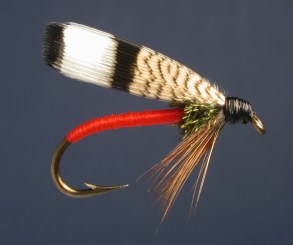Invicta Flies - Cajun Coachman
Thanks to Alberto Jimeno of New Hampshire for contributing this fine pattern.
The Cajun Coachman was created by Tom Nixon of Louisiana, and is one of the sharpest patterns I've ever seen. Barred wood duck wings over the red floss body demand attention, and the peacock herl thorax and hackle throat provide enticing movement. To add durability to the pattern Alberto uses Uni-Stretch, coating the thread base with cement just prior to wrapping. He finds the pattern most successful with an active retrieve, twitching the rod tip to "dance" the fly through the swing.

*tied by Alberto Jimeno
Hook: Mustad 3906B, #10-14
Thread: 6/0 black
Body: red floss wrapped partially into the bend
Thorax: peacock herl
Wing: barred section from wood duck flank feather
Throat: brown hackle fibers
Tying Instructions:
1) Secure tying thread to shank just behind the eye and wrap back in smooth, touching wraps to about 1/4 into the bend. Reverse and wrap back to about 1/3 of the shank behind the eye. Keeping the thread wraps smooth will help lay a smooth floss body.
2) Tie in the red floss where the thread is now, and wind back into the bend over the thread foundation. Reverse and wind back to the tying thread. Keep each layer as flat and smooth as possible, creating a slim body. Tie off the floss and clip the excess.
3) Select three full peacock herls and tie these in on top of the shank by the tips. Advance the thread to about one and a half hook eye widths behind the eye. Stroke the peacock herl backwards to get the fibers to stand out from the stem, and twist the three together to form a "rope." Wrap this forward to the tying thread, tie off, and clip the excess. For more on peacock herl, see "Tying Techniques: Peacock Herl."
4) Align and trim a section of soft, brown hackle fibers as wide as the hook gap. Bundle the fibers together and tie in on the underside of the hook so the tips reach, or are just shy of, the hook point. Trim the excess butt ends.
5) Select a wood duck flank feather with the white and black barring on the edge. Carefully trim a section about one and a half times the hook gap in width. Adjust as necessary to achieve a flat edge along the barring, then carefully fold the section in half lengthwise. Use the pinch-loop method to tie this in on top of the hook, letting the edge reach the hook bend. Trim the excess butt ends at an angle.
6) Build up a full, rounded head with the tying thread. Whip finish, clip the thread, and coat the wraps well with glossy head cement.